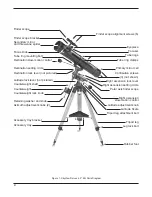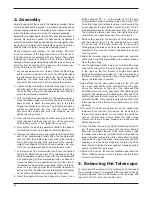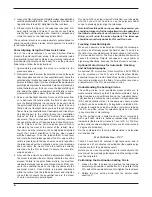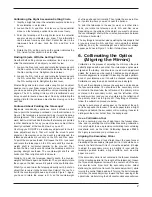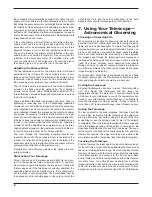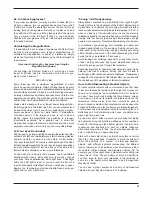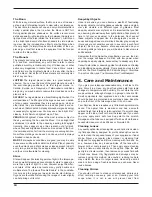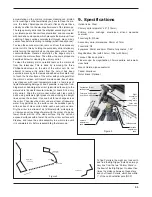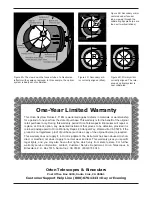
6
3. Loosen the Dec. lock lever and rotate the telescope optical tube
until it is parallel with the R.A. axis. The pointer on the Dec. set-
ting circle should read 90°. Retighten the Dec. lock lever.
4. Lift and rotate the tripod so the telescope tube (and R.A.
axis) points roughly at Polaris. If you cannot see Polaris
directly from your observing site, consult a compass and
rotate the tripod so the telescope points North.
The equatorial mount is now approximately polar-aligned for
casual observing. More precise polar alignment is required
for astrophotography.
Polar Aligning Using the Polar Axis Finder
One of the unique features of your new SkyView Deluxe
mount is the polar axis finder scope. It fits conveniently inside
the equatorial mount, and contains a tiny star map that makes
precise polar alignment quick and easy. To use the polar axis
finder scope, follow these instructions:
1. Approximately polar-align the mount as outlined in the
procedure above.
2. Remove the caps that cover the polar finder (one on the polar
finder’s eyepiece and one on the equatorial mount). Focus the
polar finder by rotating its eyepiece. Now, sight Polaris in the
polar axis finder scope. If you have followed the approximate
polar alignment procedure accurately, Polaris will probably be
within the field of view. If it is not, move the tripod left-to-right,
and adjust the latitude up-and-down until Polaris is some-
where within the field of view of the polar axis finder scope.
3. Shine a red flashlight down the front end of the polar find-
er to illuminate the reticle within the field of view. Make
sure the flashlight shines in at an angle, so as not to block
the polar finder’s field of view. It may be helpful to have a
friend hold the flashlight while you look through the polar
finder. Note the constellations Cassiopeia and Ursa Major
(the Big Dipper) in the reticle (ignore the constellation
Octans, as this is provided for Southern Hemisphere
observers). They do not appear to scale, but they indicate
the general positions of Cassiopeia and Ursa Major rela-
tive to Polaris and the north celestial pole (which is
indicated by the cross at the center of the reticle). Next,
the reticle must be rotated so the constellations depicted
match their current orientation in the sky when viewed
with the naked eye. To do this, release the R.A. lock lever
and rotate the main telescope about the R.A. axis until the
reticle is oriented with the sky. You may need to reposition
the telescope about the declination axis so the telescope
does not bump the mount. Once the reticle is correctly
oriented, use the R.A. lock lever to secure the main tele-
scope’s position.
4. Now, use the azimuth and latitude adjustment knobs on
the mount to position the star Polaris inside the tiny circle
marked “Polaris” in the polar finder’s reticle. You must first
release the latitude lock lever and loosen the bolt that con-
nects the equatorial head to the tripod (underneath the
equatorial mount). Once Polaris is properly positioned
within the reticle, lock the latitude lock lever and retighten
the bolt that connects the equatorial head to the tripod.
You are now precisely polar-aligned.
If you do not have a clear view of Polaris from your observing
site, then you will not be able to use the polar axis finder
scope to precisely polar-align the telescope.
Note that from this point on in your observing session, you
should not make any further adjustments in the azimuth or
the latitude of the mount, nor should you move the tripod.
Doing so will undo the polar alignment. The telescope
should be moved only about its R.A. and Dec. axes.
Tracking Celestial Objects
When you observe a celestial object through the telescope,
you’ll see it drift slowly across the field of view. To keep it in
the field, if your equatorial mount is polar-aligned, just turn the
R.A. slow-motion control. The Dec. slow-motion control is not
needed for tracking. Objects will appear to move faster at
higher magnifications, because the field of view is narrower.
Optional Motor Drives for Automatic Tracking
and Astrophotography
An optional DC motor drive (Orion AccuTrack SVD, #7825)
can be mounted on the R.A. axis of the SkyView Deluxe
equatorial mount to provide hands-free tracking. Objects will
then remain stationary in the field of view without any manu-
al adjustment of the R.A. slow-motion control.
Understanding the Setting Circles
The setting circles on an equatorial mount enable you to
locate celestial objects by their “celestial coordinates.” Every
object resides in a specific location on the “celestial sphere.”
That location is denoted by two numbers: its right ascension
(R.A.) and declination (Dec.). In the same way, every location
on Earth can be described by its longitude and latitude. R.A.
is similar to longitude on Earth, and Dec. is similar to latitude.
The R.A. and Dec. values for celestial objects can be found
in any star atlas or star catalog.
The R.A. setting circle is scaled in hours, from 1 through 24,
with small hash marks in between representing 10-minute
increments (there are 60 minutes in 1 hour of R.A.). The Dec.
setting circle is scaled in degrees (there are 60 arc-minutes in
1 degree of declination).
So, the coordinates for the Orion Nebula listed in a star atlas
will look like this:
R.A. 5h 35.4m Dec. –5° 27'
That’s 5 hours and 35.4 minutes in right ascension, and –5
degrees and 27 arc-minutes in declination (the negative sign
denotes south of the celestial equator).
Before you can use the setting circles to locate objects, the
mount must be precisely polar aligned, and the setting circles
must be calibrated.
Calibrating the Declination Setting Circle
1. Loosen the Dec. lock lever and position the telescope as
accurately as possible in declination so it is parallel to the
R.A. axis of the equatorial mount. Re-tighten the lock lever.
2. Rotate the Dec. setting circle until the pointer reads
exactly 90°.


